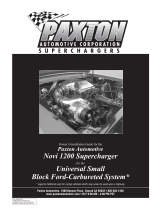Page is loading ...

OPERATION AND ENGINE STARTUP CONSIDERATIONS:
1. Installation
a. Engine oil fed units - the supercharger must be
mounted within 45° of vertical. That is 45° to the left or
right with the lowest of the three oil return provisions
selected for the drain.This is to provide proper oil control
and drain-back.
b. Self-lubricated units - These units are NOT “universal fit”.
Proper installation of a self-lubricated supercharger
requires the unit to be configured in the application as
either 45º left tilt, 45º right tilt or zeroº tilt (straight up).
Consult with Vortech/Paxton prior to engineering a
custom self-lubricated supercharger application.
c. The input shaft must be parallel to the crankshaft.
2. Start-up
a. Never operate your engine at full throttle when the
engine is cold. When starting the engine each day,
allow plenty of time for the oil to reach full operating
temperature before running above 2,500 RPM.
b. Full supercharger operating temperature is generally
achieved after the engine water temperature has been at
the normal operating range for two or three minutes.
IMPORTANT COLD WEATHER INFORMATION: In order to achieve
the low noise level of Vortech/Paxton superchargers, Vortech/
Paxton specifies manufacturing procedures that call for minimal
internal clearance. These precise tolerances however are not
conducive to temperatures below 25° F. Therefore, storing the
vehicle in a heated garage and/or employing the use of an engine
block heater/aftermarket engine blanket is required when the
vehicle is subjected to a “cold startup” in ambient temperatures
below 25° F. Failure to comply with this may result in immediate
supercharger failure and invalidate the supercharger warranty.
3. Impeller speed
a. Maximum impeller speeds are not the same for all units.
No unit will run at its maximum speed continuously
without optimum conditions and additional coolers,
filters, etc. Refer to the Support section of the Vortech/
Paxton website to find the maximum speed for your
specific model of supercharger.
b. Rapid engine/supercharger deceleration may cause
engine and/or supercharger failures. Any “free revving”
of the engine without a load on it can cause premature
supercharger failure.
NOTE: Increased impeller speeds can increase boost pressure, but
may do so with a penalty to supercharger efficiency. Compressors
must be properly matched to each application.
SUPERCHARGER SUPPORT SYSTEM GUIDELINES:
1. Air Intake – Always use an air filtration system on the
inlet of the supercharger to prevent the supercharger
from ingesting foreign objects. The filter must be in
good condition and properly secured. If equipped with
flex hose, this must be free of damage/leaks.
2. Drive Belt - Excessive belt tension can lead to supercharger
or crankshaft bearing failure. Never use a cog-type belt on a
non-heavy duty (H/D) spec supercharger.
3. Pulleys - If your supercharger drive belt comes off it may
be due to misalignment of the supercharger pulleys caused
by installation problems or movement of the mounting
plate. Misalignment can also be caused by over tightening
(and failing) of the belt, which can negatively affect the
supercharger and crankshaft bearings.
4. Compressor bypass valve – Always use an appropriately
sized compressor bypass valve for the application.
Contact Vortech/Paxton for assistance on compressor
bypass valve selection.
NORMAL MAINTENANCE GUIDELINES:
1. Engine Oil Fed Units Only
a. Clean the supercharger oil inlet fitting every 12,000
miles. When the vehicle is cold, remove the oil inlet fitting
at the supercharger and clean it thoroughly utilizing high
pressure air to blow the orifice clean before reinstallation.
Do not attempt to remove the screen/filter inside of the
oil feed fitting. This oil inlet fitting is designed with a very
small orifice, which provides a mist of oil directly onto the
gears. Never use Teflon tape or other sealants on any oil
feed line fitting. Do not over-tighten fittings.
b. Follow the heavy duty/severe usage maintenance schedule
in your vehicle owner’s manual. Use the manufacturer’s
engine oil and oil filter recommendations.
Do not use engine oil additives as they may contain solid
particulates which can clog the supercharger feed line.
2. Self-Lubricated Units Only
a. Check the supercharger fluid level using the dipstick at
least every 2,500 miles.
b. Initial supercharger fluid change must be performed at
2,500 miles. The supercharger fluid must then be
changed at least every 7,500 miles.
i. Drain the fluid, re-fill the unit only with 4 oz. of
Vortech/Paxton supplied lubricating fluid.
ii. Confirm proper oil level using the dipstick. DO NOT
OVERFILL!!
c. Fluid level checking procedure:
i. Ensure that the .06” copper sealing washer is located
on the dipstick base.
ii. Thread the clean dipstick into the unit until it seats.
iii. Once the dipstick has seated, remove the dipstick from
the unit. Fluid should register in the crosshatched area
on the dipstick.
iv. DO NOT OVERFILL!! Drain excess fluid from the unit if
it is above the maximum level on the dipstick.
WARNING: The use of any fluid other than the Vortech/Paxton
supplied special lubricating fluid will void the warranty and may
cause component failure.
SUPERCHARGER USER GUIDE:
The following information and recommendations are designed to promote years of trouble-free service for your supercharger. If the
unit is given proper care and is operated using the recommendations and instructions set forth in this guide, the unit will last the life
of most vehicles.
Ensure that you have selected the correct compressor and impeller speed for the job. APG (
AIR
POWER GROUP) offers compressor
matching services to help you select the proper supercharger for your application. If the vehicle is modified in addition to the
supercharger (i.e., heads, cam, etc.) or you have increased the impeller speed, or are creating a custom installation, you must follow
guidelines outlined in the Vortech/Paxton Racing Supercharger Owner’s Manual Guide (P/N: 008515). As an additional reference,
please see the Vortech/Paxton Street Supercharger System owner’s manual (P/N: 008516).
008531 v1.0
For More Information please visit:
vortechsuperchargers.com
or paxtonauto.com
Or Call : 805.247.0226
/










